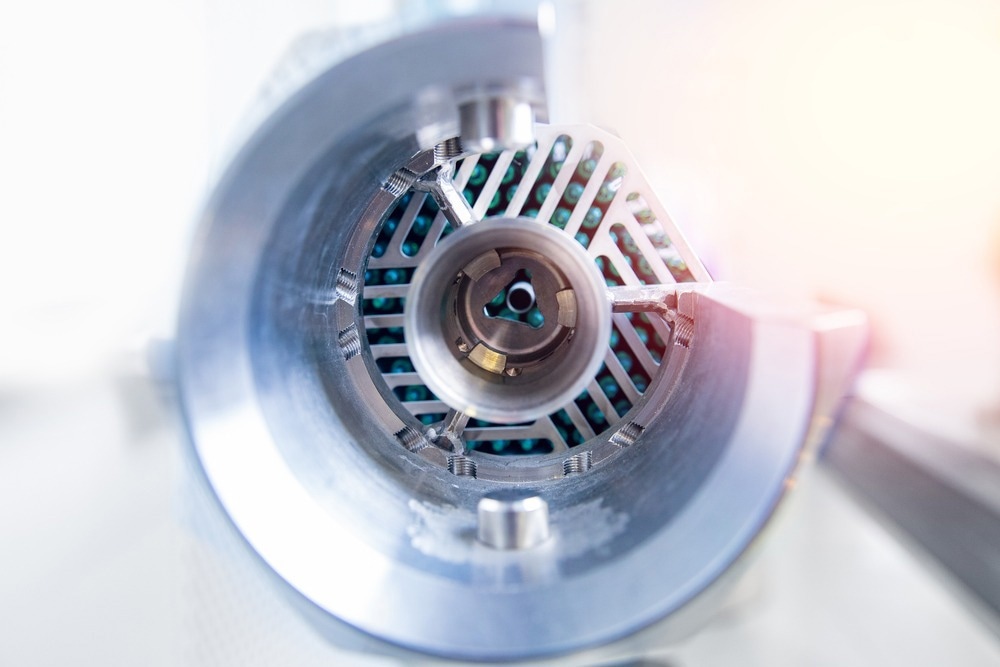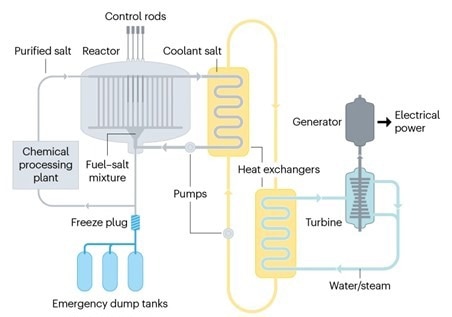Thorium reactors have been a fascinating area of nuclear research for many years, with many historical projects and much research completed in line with early uranium research.

Image Credit: Parilov/Shutterstock.com
Understanding Thorium Reactors
Thorium is a relatively abundant fertile material for use within nuclear reactors. It is approximately three times as abundant as uranium with an average distribution of ten parts per million (ppm) within the Earth's crust.
This makes thorium almost three times as abundant as uranium. Its fertile nature means that thorium itself is not fissile but can transmute into uranium-233, a fissile material.
Thorium fuels therefore require a driver to function because they cannot sustain a chain reaction on their own as a surplus of neutrons is absent. However, the aforementioned uranium-233 isotope, as well as uranium-235 or plutonium-239, can be added to the fuel to supply the needed neutrons as they decay.
Thorium reactors use thorium as their primary fuel source, whereas uranium-based reactor uses uranium-235 as its main fuel source.
Thorium reactors achieve their highest efficiency when configured as molten salt reactors (MSRs). These MSRs distinguish themselves from conventional reactors by their lack of solid fuel rods to drive the chain reaction and, in turn, energy generation. Instead, MSRs employ a suspension of molten salts, typically fluoride salts, in which the nuclear fuel is dissolved.

Image Credit: US Department of Energy/International Atomic Energy Agency
Safety Advantages of Thorium Reactors
Thorium reactors possess inherent safety features, given that they cannot maintain a chain reaction and are less prone to a traditional nuclear meltdown. In the context of molten salt reactors, there is no need for an external cooling system, as the molten salts serve as both the reactor's cooling medium and fuel containment.
The reaction materials can also be drained from the reactor in an emergency. The molten salt reactors deploying thorium are also considered safer than standard uranium-fueled reactors due to their operating pressures, which are much closer to atmospheric pressure, reducing the risk of any explosion or damage due to pressure build-up.
For comparison, an extensive water cooling system cools the fuel rods in conventional uranium reactors. If this system fails, the fuel rods melt, releasing hazardous radiation. This is not dissimilar from the incident at the Chernobyl Nuclear Power Plant in 1986, as molten nuclear fuel was found in the basement of reactor number four.
Minimal Radioactive Waste and Longevity
Nuclear reactors do not consume the entire fuel rods before the rods are replaced. Instead, the rods become less able to provide neutrons to sustain the chain reaction and eventually need to be replaced. However, the spent rods become irradiated nuclear waste, which emits harmful radioactive ions and various types of ionizing radiation capable of damaging ecosystems and causing health problems in humans and other mammals.
An added benefit of thorium reactors is that the nuclear waste does not emit as much harmful radiation and is less long-lived than that produced by a conventional reactor.
Uranium reactors, on average, have a lifespan of 30-60 years, depending on their age and any refurbishment. On the other hand, thorium molten salt reactors can operate for approximately 60 years before needing refurbishment, theoretically pushing their life expectancy to at least a further 20 years.
Environmental Benefits of Thorium Reactors
All nuclear reactors do not emit greenhouse gases but thorium molten salt reactors have the added benefit of radioactive waste that has a shorter half-life than that produced by conventional reactors.
These molten salt reactors may also reduce plutonium stores, which could be used as a driver for the production of uranium-233.
This means that the reactors could not only be used to produce energy with greater efficiency, but they may also be able to be used to reach sustainability goals as they have reduced greenhouse gas emissions and be able to reduce plutonium stocks, which could further help meet goals sooner as dangerous radioactive waste is recycled rather than stored.
Challenges and Technical Hurdles of Thorium Reactors
Some issues have arisen when developing thorium reactors, and many utilities have viewed the process of turning fertile thorium into a fissile fuel as not economically viable. Other challenges encompass the cost of mining and extracting thorium from rocks, especially in light of uranium's widespread use in nuclear power, necessitating thorough research into the application of thorium.
The research expenses are comparable to the costs of thorium extraction, and the reactors would require extensive testing before being considered both commercially secure and economical. Another challenge involves the potential proliferation of nuclear waste, although this risk is significantly lower compared to that associated with conventional depleted uranium fuel rods. However, there remains a possibility, particularly concerning the by-products of the fueling process.
The uranium-233 that acts as a driver for this process is most notable. The International Atomic Energy Agency classifies uranium-233 in the same risk category as high-energy enriched uranium, with a significant quantity of uranium-233 being four times smaller than the significant quantity of the enriched uranium. For reference, the significant quantity is only 8 kilograms.
The production of uranium-233 also produces uranium-232, a high emitter of gamma radiation which is hard to shield against. This is also true of some of the decay products of uranium-233, such as thallium-208. This makes the fissile fuel easy to detect but difficult to safely handle.
International Developments and Adoption
In January 2011, the Chinese Academy of Sciences began researching and developing a Liquid Fluoride Thorium Reactor, which utilized uranium-233 that had been transmuted from a liquid thorium salt blanket. This reactor was first tested in September 2021 and used two different fuel types - a solid fuel pellet and liquid salts, as in an MSR.
Researching thorium as a potential nuclear fuel has been conducted for over 50 years. It was initially studied alongside uranium as an early fissile fuel and was analyzed in Canada, Russia, Japan, India, Germany, the UK, and the USA, to name a few.
The Bhabha Atomic Research Center in India has designed a heavy water reactor (AHWR300-LEU) that uses a multicomponent fuel mixture of thorium and low-enriched uranium. The thorium within this fuel is believed to provide approximately 39% of the reactor's power output with an average burn-up rate of 64 Gigawatt-days per ton (GWd/t).
This burn-up rate is around 20 GWd/t greater than modern uranium reactors, which have a 45 GWd/t burn-up. This means the same amount of the thorium-uranium hybrid fuel can theoretically provide much more energy, making this fuel more attractive for use in reactors.
This new thorium-uranium hybrid has the potential for use in several older generation heavy water moderated and light water boiling reactors. Possible international collaboration opens many opportunities for further research into potential thorium fuels and their benefits toward more efficient and cleaner energy production with less harmful waste.
The Future of Thorium Reactors
Thorium reactors are a fascinating prospect for the future of clean, safer nuclear power with hopes of more efficient production. Further research still needs to be completed, and regulations surrounding the fuels must be implemented to limit proliferation.
These reactors are cleaner, and with more international research projects beginning and research being completed by international bodies and governments, thorium reactors are becoming a more than likely future for nuclear-driven power production.
Read More: Making Nuclear Energy Use Safer with Artificial Intelligence
References and Further Reading
INTERNATIONAL ATOMIC ENERGY AGENCY, Near Term and Promising Long Term Options for the Deployment of Thorium Based Nuclear Energy, IAEA-TECDOC-2009, IAEA, Vienna (2022) URL: https://www.iaea.org/publications/15215/near-term-and-promising-long-term-options-for-the-deployment-of-thorium-based-nuclear-energy
Bhabha Atomic Research Centre. (n.d.). AHWR300-LEU. Bhabha Atomic Research Centre. Retrieved October 17, 2023, from https://www.barc.gov.in/reactor/ahwr.pdf
Dumé, I. (2022, March 31). Can thorium compete with uranium as a nuclear fuel? Polytechnique Insights. Retrieved October 17, 2023, from https://www.polytechnique-insights.com/en/braincamps/energy/the-latest-technological-advances-in-nuclear-energy/can-thorium-compete-with-uranium-as-a-nuclear-fuel/
Mallapaty, S. (2021, September 10). nature, 597, 311-312. https://doi.org/10.1038/d41586-021-02459-w
Vlasov, A. (2023, March 13). Thorium's Long-Term Potential in Nuclear Energy: New IAEA Analysis | IAEA. International Atomic Energy Agency. Retrieved October 17, 2023, from https://www.iaea.org/newscenter/news/thoriums-long-term-potential-in-nuclear-energy-new-iaea-analysis
World Nuclear Association. (2020, November). Thorium. World Nuclear Association. Retrieved October 17, 2023, from https://world-nuclear.org/information-library/current-and-future-generation/thorium.aspx
Disclaimer: The views expressed here are those of the author expressed in their private capacity and do not necessarily represent the views of AZoM.com Limited T/A AZoNetwork the owner and operator of this website. This disclaimer forms part of the Terms and conditions of use of this website.